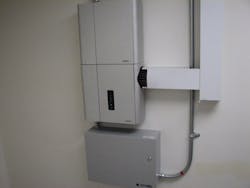Correctional facilities face unique challenges when it comes to protecting inmates, correctional officers and other personnel from the danger of smoke and fire.
Although smoke detectors are required for every inmate sleeping area, including housing and treatment center cells, traditional fire detection technology installed in the return air chase or ductwork can become compromised by an accumulation of dirt and grime. When the smoke detector senses enough build-up, an alarm is sent to the control panel for immediate attention.
At that point, maintenance personnel must climb up to the ducting to clean the smoke detector and restore it to full functionality. This process is so tedious and time consuming that one fire protection specialist estimates it would require a full time technician at a cost of $120,000 per year to clean all the smoke detectors in the system as needed.
The requirement is so cumbersome that in some prisons maintenance of the devices has all but ceased. In addition, duct smoke detectors trigger so many nuisance alarms they are often disconnected from the fire alarm panel, leaving correctional officers to act as “fire watch.”
In an effort to reverse this trend and keep these systems fully operational, however, facilities such as Corcoran State and Kern Valley prisons with the guidance of the California Department of Corrections and Rehabilitation (CDCR) are installing alternative smoke detector technology that is self-cleaning, requires minimal maintenance and eliminates the nuisance alarms.
Corcoran State Upgrades Fire Alarm System
Building Electronic Controls (BEC), a leading independent fire life safety firm with experience in the corrections industry has been working with the CDCR for several years to update aging smoke detection alarm systems across the Central Valley state prisons.
The company has already installed standard duct smoke detector systems in several correctional facilities, including Kern Valley State Prison. In the past year, BEC completed an entire fire system upgrade at Corcoran State Prison for the hospital treatment area cells.
“The housing cells are notorious for creating more dirt and lint than the rest of the facility,” says Patrick Neff, Manager of the Bakersfield, California Branch of BEC. “So the CDCR was having a problem with the smoke detectors causing all these ‘trouble’ alarms at the control panel.”
According to Neff, the geographical location and the fact that many correctional facilities have dirty outside air pulled in through the air handling system can also contribute to the quick build-up of dirt.
“State prisons here in Central California are often built in farming areas where there is a lot of dirt and pollen in the air throughout the entire year,” says Neff. “They can also be built in the middle of the desert.”
Neff says that the decision to turn to aspirating smoke detection technology was driven by the CDCR. Several years ago, the department began investigating and beta testing the VESDA-E VEA fire alarm system manufactured by Xtralis. The company is a global provider of early detection and remote visual verification of fire, gas and perimeter threats.
These systems work by aspirating – or drawing in – air through small, flexible tubes located in ductwork or return air chase. The sample travels through the tubes and is analyzed using sophisticated laser-based technology at a central unit located in a restricted area within 300’.
A single system supports up to 40 sample points and can be extended to 120. As a multi-channel, addressable system, the VEA central unit can pinpoint the exact location of the alarm.
The VEA system also offers earlier detection than photoelectric technology detectors. The system is able to detect minor particles in the air much faster, even before a fire begins to flame and burn. In many cases, early warnings can speed evacuation and prevent fire from spreading to other areas.
In California’s Central Valley, BEC recently installed a VEA system with 102 sampling points in the hospital area of its Corcoran facility. The unit is divided into four separate wings, with each inmate housed in an individual cell. A similar VEA system is already scheduled for installation at the Kern Valley State Prison in its housing units as well.
This aspirating technology has already proven successful in reducing the maintenance required. Each tube is self-cleaning and the system detects any blockages or breaks in the tubing.
“The VEA aspirating system is set to clean itself every seven days,” adds Neff. “This eliminates any dust accumulation issue. Even if dust enters the tubing system, the filters for all the sampling points are located at the central unit in a restricted area, and only take a minute to clean. There is no need to crawl to duct to get to the detector.”
National Fire Protection Association (NFPA) annual inspections are also simplified. Unlike traditional smoke alarms, systems like VEA do not require testing of each sample point annually at its location in the duct. Instead, the tests can be conducted at the central unit.
“It makes so much sense for prisons to use this technology in housing cells,” says Neff. “With the aspirating smoke detection system, the maintenance costs are about 5% of what they would be for duct smoke detectors, so it’s quite a savings,” explains Neff.
For more information, contact Xtralis at 175 Bodwell Street, Avon, MA 02322, call: +1 (619) 252-2015; email: [email protected] or visit: www.xtralis.com/vea



